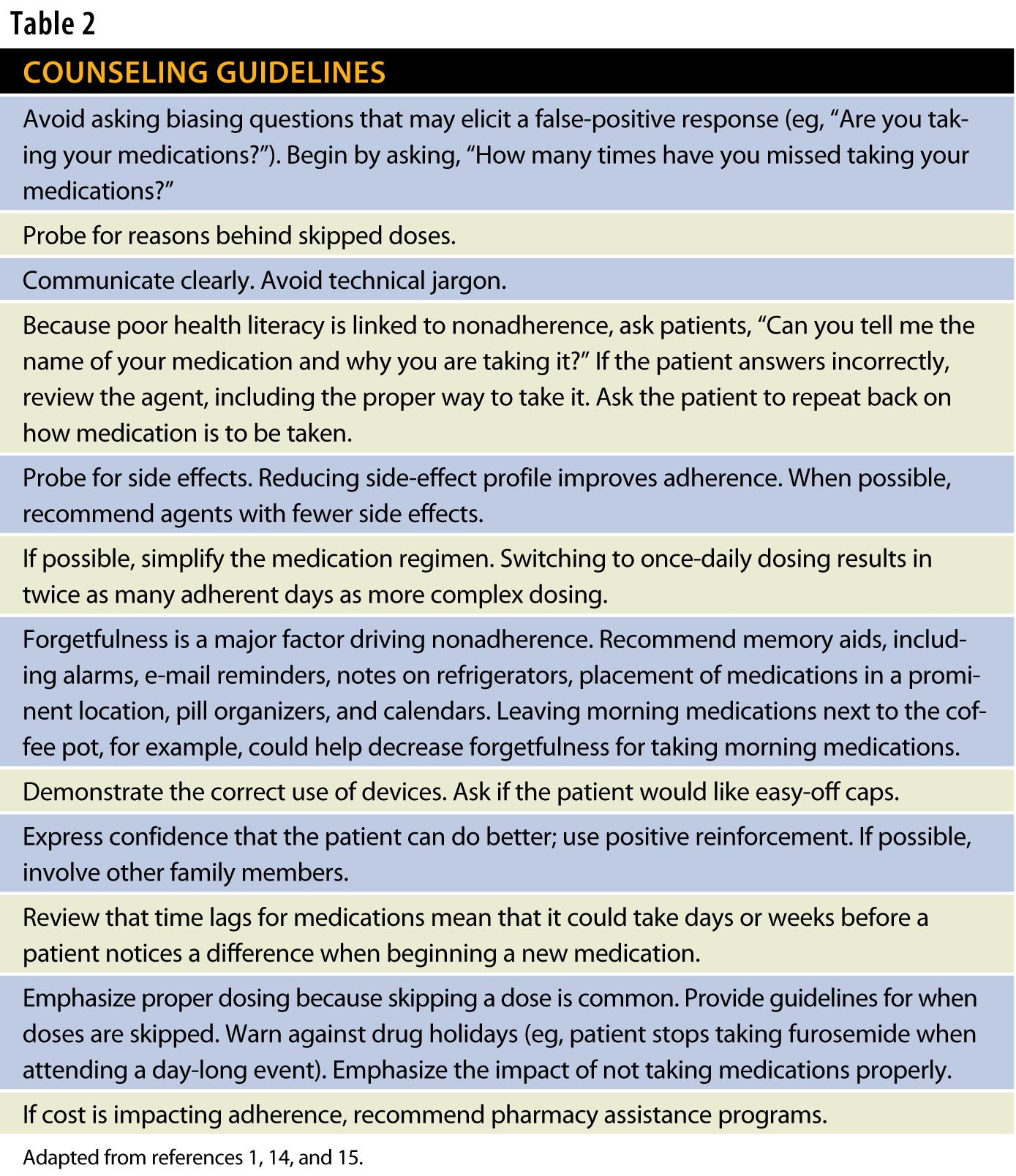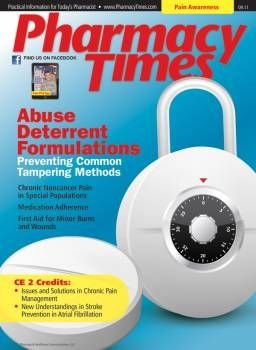Counseling for Improved Medication Adherence
Pharmacists have the tools and expertise to deliver personalized adherence coaching that improves therapeutic outcomes and reduces health care costs.
Pharmacists have the tools and expertise to deliver personalized adherence coaching that improves therapeutic outcomes and reduces health care costs.
Medication adherence—the extent to which patients take medications as prescribed by their providers and agreed upon in the treatment plan—is essential for optimizing health outcomes.1,2 The term previously used, “medication compliance,” has fallen out of favor, because it suggests the patient is passively following orders, as opposed to being actively involved in treatment planning.

Nonadherence takes many forms (Table 13) and statistics on the number of unfilled prescriptions are stunning. One large-scale study found 22% of prescriptions go unfilled, a statistic that climbs to 28% for new prescriptions. Nonadherence rates were even higher for pain medications, where only 45% of new prescriptions were filled.
Nonadherence rates were the lowest for prescriptions written by the patients’ primary care physicians (16%) and prescriptions written for patients 18 years and younger (13%).4 Despite these and other research findings reporting that only 50% to 60% of patients are medication adherent,2 only 8% of patients acknowledge nonadherence.5
Medication nonadherence is linked to disease worsening, increased mortality, and increased health costs. It is estimated, for example, that improved adherence to antihypertensive treatment could prevent 89,000 premature deaths in the United States annually.6 Furthermore, 33% to 69% of all medication-related hospital admissions stem from poor medication adherence.1
Defining and Measuring Adherence
Adherence rates are generally defined as the percentage of correct doses taken over a period of time. Currently, however, there is no definitive benchmark for acceptable adherence; some clinicians consider 80% as acceptable, whereas others use a 95% benchmark.1 To a large extent, acceptable adherence rates vary by disease. For example, because poor adherence is linked to increased viral load,7 those working with HIV patients emphasize 95% to 100% medication adherence. Studies suggest, however, that average adherence among HIV patients is 75%.8
Currently, no gold standard exists for measuring adherence. Biological assays, pill counts, weight of topical medications, electronic monitoring, pharmacy records, prescription claims, and patient interviews have all been used to measure adherence, but each is accompanied by methodological disadvantages.9 Although pill counts are the most common measure employed, studies suggest pill counts underestimate adherence.9 Patients, for example, may miss a dose, and then double up the dose later on.
Factors Impacting Adherence
Adherence rates are generally higher for patients with acute conditions compared with adherence for those with chronic conditions. Adherence drops significantly after the first 6 months of treatment.1 For some conditions, the drop comes sooner—up to 50% of patients treated for depression discontinue treatment within the first 3 months of therapy.1

Patient characteristics impacting adherence include advanced age, cognitive impairment, depression, substance abuse, asymptomatic disease, belief systems about medications, lack of trust for health care providers, poor literacy, language, religion, socioeconomic level, culture, and race.10,11 Hispanics and African Americans, for example, have lower adherence rates compared with Caucasians.11
Along with patient characteristics, other factors that impact adherence include polypharmacy and medication regimen complexity, lack of immediate treatment effect, high medication costs and copayments, lack of support systems, adverse effects, and poor communication between provider and patient.6,10 Typical reasons cited by patients for not taking medications include forgetfulness (30%), other priorities (16%), a decision to skip a dose (11%), lack of information (9%), and emotional factors (7%).1 For those 50 years and older who fail to fill a prescription, cost was a factor in 40% of the cases.5
Promising Strategies
A Cochrane review concludes that no single strategy exists for improving adherence across all diseases, populations, or settings. Strategies with the strongest evidence include self-monitoring and self-management, simplified dosing, and direct pharmacy involvement. Other strategies, such as reminders, education combined with self-management skills training, counseling, support, and financial incentives, show promise, but current evidence is lacking regarding their effectiveness for improving long-term adherence.12 Electronic medication event monitoring systems are effective, but they are costly and somewhat cumbersome to use.13
Effective Counseling
Understanding risk factors for nonadherence provides the basis for effective counseling. Predictors of poor adherence include visual problems, inability to open child-proof caps, complex medication regimens, poor understanding of the disease being treated, the impact of the side effect profile, depression, asymptomatic disease, high costs or copayments, and cognitive impairment.1
Researchers are constantly evaluating improved treatments, but in the absence of new treatments, medication adherence has a significant impact on improving patient outcomes. Direct pharmacy involvement definitely improves adherence and patient outcomes.10 Each patient must be evaluated to understand the barriers preventing the patient from adherence. Multiple strategies work best. Table 214,15 highlights useful counseling tips.
Dr. Zanni is a psychologist and health systems consultant based in Alexandria, Virginia.
References
1. Osterberg L, Blaschke T. Adherence to medication. N Engl J Med. 2005;353:487-497.
2. Lavsa SM, Holzworth A, Ansani NT. Selection of a validated scale for measuring
medication adherence. J Am Pharm Assoc (2003). 2011;51:90-94.
3. Fischer MA, Stedman MR, Lii J, et al. Primary medication non-adherence: analysis of 195,930 electronic prescriptions. J Gen Intern Med. 2010;25:284-290.
4. Boehm E, Brown E, McEnroe W. Rx adherence hits the ignorance wall: why pharma and payers must put more muscle behind drug compliance. Forrester Research Web site. www.forrester.com/rb/Research/rx_adherence_hits_ignorance_wall/q/id/39173/t/2. Published April 14, 2006.
5. Overview: medication adherence—where are we today? Adult Meducation Web site. www.adultmeducation.com/OverviewofMedicationAdherence.html. Accessed July 27, 2011.
6. Cutler DM, Everett W. Thinking outside the pillbox--medication adherence as a
priority for health care reform. N Engl J Med. 2010;362:1553-1355.
7. de Bruin M, Viechtbauer W, Schaalma HP, Kok G, Abraham C, Hospers HJ. Standard care impact on effects of highly active antiretroviral therapy adherence interventions: A meta-analysis of randomized controlled trials. Arch Intern Med. 2010;170:240-250.
8. Smith SR, Rublein JC, Marcus C, Brock TP, Chesney MA. A medication self-management program to improve adherence to HIV therapy regimens. Patient Educ Couns. 2003;50:187-199.
9. SC Cooperative for Healthy Aging in Minority Populations Resource Centers for Minority Aging Research. Measuring medication adherence. www.musc.edu/dfm/RCMAR/MedAdherence.html. Accessed July 20, 2011.
10. Simpson RJ Jr. Challenges for improving medication adherence. JAMA. 2006;296:2614-2616.
11. Manias E, Williams A. Medication adherence in people of culturally and linguistically diverse backgrounds: a meta-analysis.Ann Pharmacother. 2010;44:964-982.
12. Ryan R, Santesso N, Hill S, et al. Consumer-oriented interventions for evidence-based prescribing and medicines use: an overview of systematic reviews. Cochrane Database Syst Rev. 2011;5:CD007768.
13. Morisky DE, Ang A, Krousel-Wood M, Ward HJ. Predictive validity of a medication adherence measure in an outpatient setting. J Clin Hypertens (Greenwich). 2008;10:348-354.
14. Albrecht S. The pharmacist’s role in medication adherence.US Pharm. 2011;36:45-48.
15. Chisholm-Burns MA, Kim Lee J, Spivey CA, et al. US pharmacists’ effect as team members on patient care: systematic review and meta-analyses. Med Care. 2010;48:923-933.

